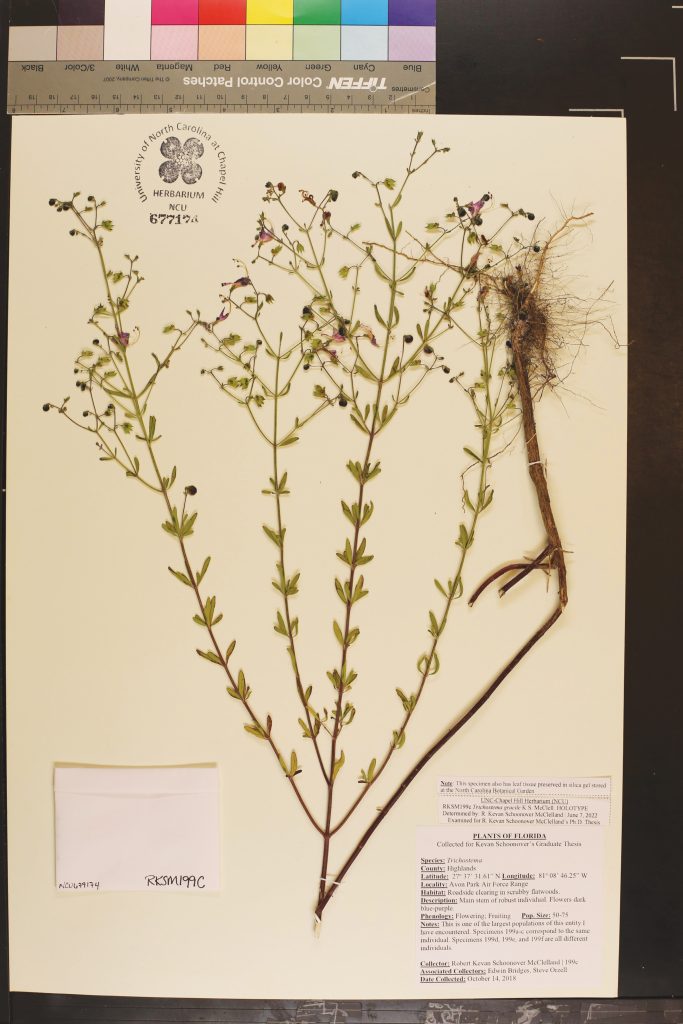By Bao Anh Tran, Communications Intern
Hidden amid similar specimens, differing only in its “weirdness,” a new plant discovered by herbarium associate Kevan Schoonover McClelland was finally given a name after lengthy efforts to identify it.
Trichostema latens, a plant in the mint family, owes its identifier to the Latin language. Latens means hidden or secret, referring to its ability to blend in with other plant populations in the southeastern United States. The plant stayed under McClelland’s radar for years before he was lucky enough to stumble upon it.
The botanist had on hand about 1500 individual Trichostema spp. specimens when he did his study and took quantitative measures of them (i.e., length and width). He noticed one special specimen that looked similar to the T. floridanum specimen that was identified before but was oddly-shaped. At the time, he thought that it was a strange outlier of T. floridanum rather than an entirely different species.
It was not until McClelland decided to take qualitative measurements of the specimens years after his initial quantitative measurements that the “weird” species finally seemed like it belonged in a new category. He found the stem hairs and leaf tips on the specimen looked different from T. floridanum. These are huge factors that can help differentiate Trichostema species, so McClelland thought someone must have mislabeled the locality of these specimens.
“I got lucky,” said McClelland.
When comparing this strange specimen six others located in the UNC herbarium collected by Loran Anderson, another botanist who had done similar research on the Trichostema species, McClelland found the first specimen looked almost identical to Anderson’s. Better yet, they were each found only a couple miles apart.
Since his leaf specimens from 2016 through 2018 were no longer viable for research, McClelland decided to take a last-minute trip to Florida in the Fall 2021 to validate his new discovery. Here, he found both populations of plants the specimens were taken from, and was able to include them into genetic analysis to confirm that it was an entirely separate species from T. floridanum.
The Coastal Plain of the southeastern United States was officially recognized as a biodiversity hotspot in 2015. However, this is not synonymous to it being a well-researched area. For a long time, flora in the southeast was assumed to be homogenous and hence, there is a lack of studies to discover the vastly different species in the region. According to Alan Weakley, McClelland’s supervisor and director of the UNC Herbarium, new findings like McClelland’s are crucial in helping with efforts to promote conservation as climate change may drive these species to the brink of extinction.
“We can’t protect what we don’t know exists,” said Weakley.
Trichostema latens is one of seven new Trichostema species found by McClelland. Also in July 2023, three non-mint species were named, whose discoveries are also associated with the North Carolina Botanical Garden.
Alongside hidden bluecurls (Trichostema latens), other plants named include:
Florida bluecurls (Trichostema floridanum)
Bushy bluecurls (Trichostema fruticosum)
Bridge’s and Orzell’s bluecurls (Trichostema bridgesii-orzellii)
Flatwoods bluecurls (Trichostema gracile)
Jobé bluecurls (Trichostema hobe)
Small-leaved bluecurls (Trichostema microphyllum)
Hiwassee goldenrod (Solidago ayuhwasi)
Spring beaksedge (Rhynchospora vernalis)
Sabulina diffusa
Our Herbarium is committed to making flora data accessible. The articles detailing this research are available to all, open access:
Mcclelland, R. K. S., Weakley, A. S., & Poindexter, D. B. (2023). Seven new species of Trichostema (Lamiaceae: Ajugoideae) from the North American Coastal Plain biodiversity hotspot. Phytotaxa, 603(2), 95–149. https://doi.org/10.11646/phytotaxa.603.2.1
Studies in the vascular flora of the southeastern United States. IX
Weakley, A. S., Kees, J. C., Sorrie, B. A., Ward, S. G., Poindexter, D. B., Brock, M., Estes, L. D., Bridges, E. L., Orzell, S. L., Levin, G. A., McClelland, R. K. S., Schmidt, R. J., & Namestnik, S. A. (2023). Studies in the vascular flora of the southeastern United States. IX. Journal of the Botanical Research Institute of Texas, 17(1), 191–257. https://doi.org/10.17348/jbrit.v17.i1.1293
